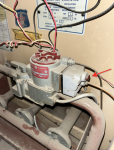Really old Lennox furnace - pilot was lit but main burners would not come on - until I pressed this red button. What’s the purpose of this button, and why would pressing it cause the burners to light? I realize a new gas valve may be in order but I would still like to know what that button does.
See pic: (the forum won’t let me post links, so copy and paste the link below and remove “*****”
https*****://drive.google.com/file/d/1VQxaa8VAWXZSMbN2iNhDxPF4MX_xUSly/view?usp=drivesdk
See pic: (the forum won’t let me post links, so copy and paste the link below and remove “*****”
https*****://drive.google.com/file/d/1VQxaa8VAWXZSMbN2iNhDxPF4MX_xUSly/view?usp=drivesdk








